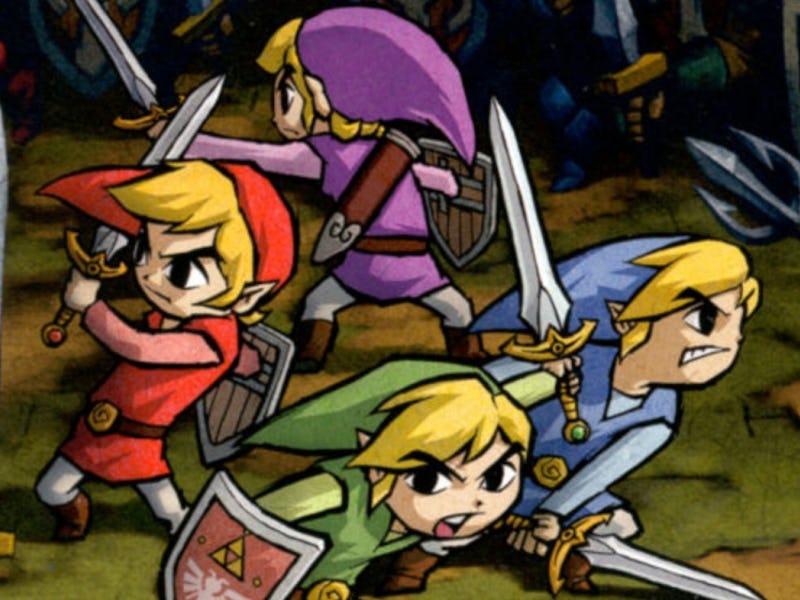The Most Overlooked Zelda Game Was Actually Just Ahead of Its Time
Four swords are better than one.

The Legend of Zelda games are a uniquely singular experience. People know the classic dungeons, puzzles, and themes that have filled the series, but it’s in how you, the player, specifically approach your journey that typically defines Link’s adventure. So what happens when that experience becomes a shared one?
Released for Nintendo GameCube on March 18, 2004, The Legend of Zelda: Four Swords Adventures offers an intriguing answer. The game is a fun experiment that explores how the addition of others changes a dynamic that we thought we knew very well. But along the way, it also reveals the defining feature of all Zelda games that keeps the franchise going strong two decades later.
Four swords are better than one.
Four Swords Adventures wasn’t technically the first game of its kind. Two years earlier, Nintendo had rereleased A Link to the Past for the Game Boy Advance, adding in Four Swords as a bonus multiplayer experience.
Four Swords Adventures took that original add-on and fleshed it out in a standalone game, changing the formula in the process. Four Swords featured randomly generated levels, while the maps in Adventures always remained the same. Four Swords also requires at least two players, while Adventures can technically be played solo even if multiplayer gameplay is encouraged.
Meanwhile, the plot of both games is pretty similar: Link suddenly has three clones of himself and then gets thrust into an adventure against the inevitable Big Bad. The purple sorcerer Vaati is your main enemy in Four Swords, while both Vaati and, you guessed it, Ganon haunt you in Adventures.
In somewhat typical Nintendo fashion, actually playing Four Swords Adventures is easier said than done. A solo run of Four Swords Adventures can be accomplished with a GameCube controller, but the multiplayer “Hyrulean Adventure” option dictates that players use a Game Boy Advance, which then necessitates a tangled mass of GameCube - Game Boy Advance link cables.
Luckily, these cables came packaged with the game itself in its North American and European releases, but every player needs one. So unless they happened to own one that they used for another game, to get four players together, you’d have to have three friends who also had Game Boy Advances and also had copies of Four Swords Adventures that came with the cord. While playing the game, this amount of jumping through technological hoops makes sense as the GBA is not only used as a controller but a screen for the player whenever they maneuver their Link off the main one or go into certain different areas.
Remember this thing?
Even in a multiplayer game, which necessitates a sense of forward progression, there are little classic touches of exploration. Being able to navigate outside of the bounds leads to the “Oooh, look at this cool new thing I found!” feeling that drives the series to this day.
When Tears of the Kingdom was released, for months, social media was filled with photos and video clips of new discoveries. These ranged from curious, hidden portions of the map to ridiculous uses of the building tools to ingenious methods of solving certain puzzles, but they all contained that same evolution of personal discovery becoming a collective joy.
Four Swords Adventures is a game constructed entirely around that feeling, only on an immediate and personal, shoulder-to-shoulder level. Instead of telling someone online or coming to school or work to share whatever new wonder you’ve managed to find, it was instead recognized by everyone on the couch.
Playing Four Swords Adventures with a bunch of friends (they’re all just out of frame).
Four Swords Adventures is far from the deepest Zelda game and doesn’t have very expansive replay value. Another gameplay mode, Shadow Battle, in which players compete against one another in combat, is chaotic fun, though it’s absolutely better when you have a full house. Still, Adventures legacy lies in how it challenges the idea that Legend of Zelda only thrives under certain conditions.
It captured in close, physical form what had long been one of the most magical traits of Legend of Zelda. It was the feeling of a journey being both universal and deeply personal at the same time and of the ability to take the intimate moments and render them as common ground across generations. Only this time, you didn’t have to go out of your way to share them.
See something neat? Your friends were right there.